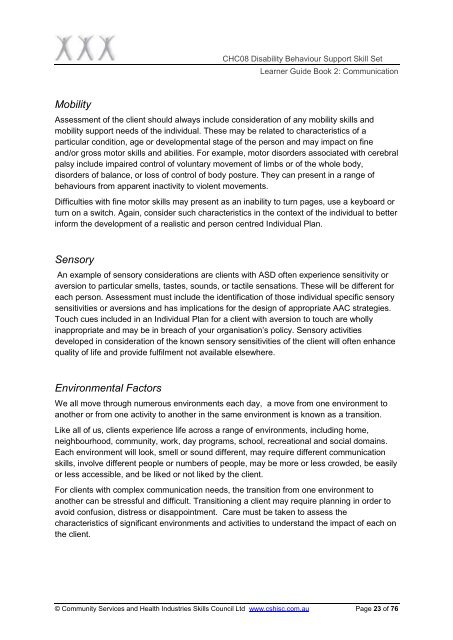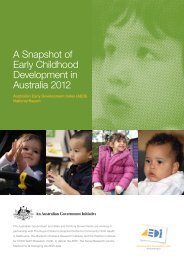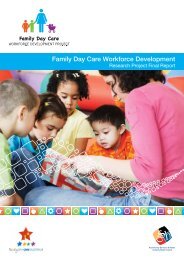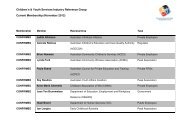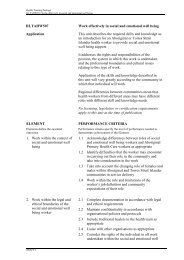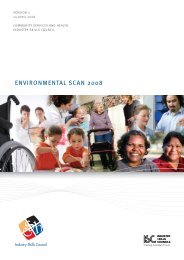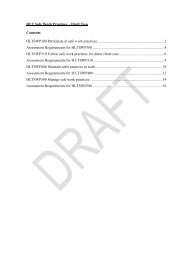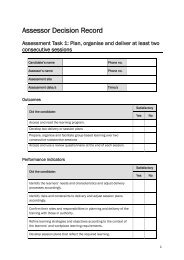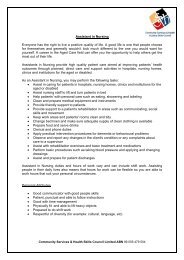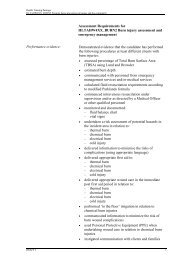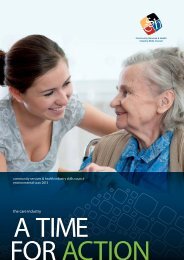CHC08 Disability Behaviour Support Skill Set Learner Resource ...
CHC08 Disability Behaviour Support Skill Set Learner Resource ...
CHC08 Disability Behaviour Support Skill Set Learner Resource ...
You also want an ePaper? Increase the reach of your titles
YUMPU automatically turns print PDFs into web optimized ePapers that Google loves.
<strong>CHC08</strong> <strong>Disability</strong> <strong>Behaviour</strong> <strong>Support</strong> <strong>Skill</strong> <strong>Set</strong><strong>Learner</strong> Guide Book 2: CommunicationMobilityAssessment of the client should always include consideration of any mobility skills andmobility support needs of the individual. These may be related to characteristics of aparticular condition, age or developmental stage of the person and may impact on fineand/or gross motor skills and abilities. For example, motor disorders associated with cerebralpalsy include impaired control of voluntary movement of limbs or of the whole body,disorders of balance, or loss of control of body posture. They can present in a range ofbehaviours from apparent inactivity to violent movements.Difficulties with fine motor skills may present as an inability to turn pages, use a keyboard orturn on a switch. Again, consider such characteristics in the context of the individual to betterinform the development of a realistic and person centred Individual Plan.SensoryAn example of sensory considerations are clients with ASD often experience sensitivity oraversion to particular smells, tastes, sounds, or tactile sensations. These will be different foreach person. Assessment must include the identification of those individual specific sensorysensitivities or aversions and has implications for the design of appropriate AAC strategies.Touch cues included in an Individual Plan for a client with aversion to touch are whollyinappropriate and may be in breach of your organisation’s policy. Sensory activitiesdeveloped in consideration of the known sensory sensitivities of the client will often enhancequality of life and provide fulfilment not available elsewhere.Environmental FactorsWe all move through numerous environments each day, a move from one environment toanother or from one activity to another in the same environment is known as a transition.Like all of us, clients experience life across a range of environments, including home,neighbourhood, community, work, day programs, school, recreational and social domains.Each environment will look, smell or sound different, may require different communicationskills, involve different people or numbers of people, may be more or less crowded, be easilyor less accessible, and be liked or not liked by the client.For clients with complex communication needs, the transition from one environment toanother can be stressful and difficult. Transitioning a client may require planning in order toavoid confusion, distress or disappointment. Care must be taken to assess thecharacteristics of significant environments and activities to understand the impact of each onthe client.© Community Services and Health Industries <strong>Skill</strong>s Council Ltd www.cshisc.com.au Page 23 of 76


